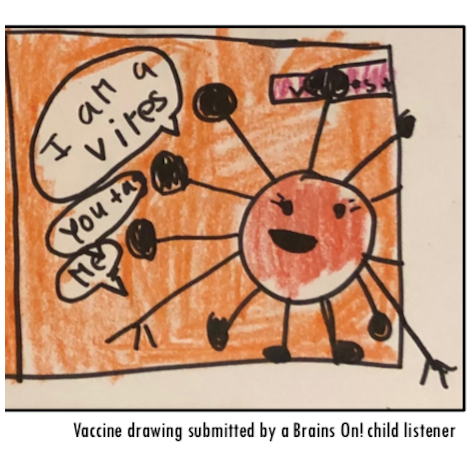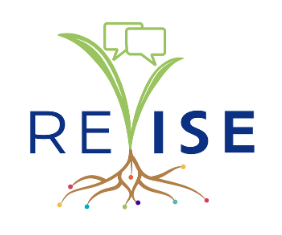
April 15th, 2021
Authors: Amy Grack Nelson, Evelyn Christian Ronning, Scott Van Cleave, Choua Her
As we pass the one year anniversary of the COVID-19 pandemic, the world continues to struggle with the many ways our lives have changed and the uncertainty that remains about the future. Vaccines are being widely administered, but how and when life will return to “normal” remains unknown. Caregivers continue to seek out information to address the questions, worries, and information needs their children have about this unique moment in their lives. Our NSF-funded RAPID research project has helped to uncover some of these questions, worries, and needs by talking to caregivers of listeners of the children’s science podcast Brains On!. The first phase of our research gathered data from families in June 2020 (see this CAISE blog post for results of that study). The second and final phase of our research gathered data in January 2021 and revealed important insights into the kinds of questions children are asking a year into the pandemic, the worries they have, and the types of support caregivers need in order to discuss the COVID-19 pandemic with their children. We hope our research findings can inform the development of coronavirus-related educational resources responsive to the needs of families during the COVID-19 pandemic.

Here are a few key findings that may be of particular interest to the ISE field:
-
A need for greater understanding about vaccines. Vaccines were a topic that came up repeatedly across our data. This isn’t surprising considering COVID-19 vaccines were just beginning to be distributed at the end of 2020 and there were still many unknowns related to vaccines. These unknowns came up in children’s questions and worries – when the vaccine will be available for kids and the people important to them, if the vaccine will work against the new variants, how long preventative behaviors will need to remain in place as people get vaccinated, how long before enough people are vaccinated so that life can go back to “normal,” and how the vaccines will help to stop the pandemic. Children want to know more about the process of developing and testing vaccines, how the vaccines work, their effectiveness, side effects, and why there isn’t a vaccine for children yet. Some of the information about vaccines is difficult for children to understand and caregivers to translate, so more kid-friendly resources need to be developed to help address any worries or fears children and their families may have in relation to getting vaccinated. The stakes couldn’t be higher for better communication about vaccines for children and their families.

-
The social and emotional impacts of the pandemic are just as important to address as the science. Children’s questions and worries were not only about the specific scientific aspects of the pandemic but how the pandemic has affected the social aspects of their life. The variety of preventative measures that children and their families are using to prevent getting sick and to keep others safe are disrupting children’s daily life in immense ways. Many children lack the everyday routines of going to school and seeing their friends and teachers in person; they miss playing with friends and interacting with extended family members; and they want to know when they can participate in some of their favorite activities again like playing sports, going on family vacations, and celebrating birthdays with others. It is important that educational efforts focused on children don’t just highlight the scientific information and public health guidance, but acknowledge the social impact this is having on children and the related emotional impacts of loneliness, sadness, and anxiety this can bring, especially given the uncertainty of when children will be able engage in social activities in “normal” ways again.
-
Helping children make sense of inconsistencies In people’s preventative behaviors. Children have questions and worries around topics that are particularly difficult for caregivers to talk about and explain. The most frequently mentioned worry is why people aren’t following preventative guidelines, which was echoed in the children’s questions in addition to questions about why some people don’t think the pandemic is real or don’t want a vaccine. These are all behaviors and opinions they see people expressing that are counter to what they hear when they listen to the Brains On! podcast and what scientists are communicating to the public. Some children were also voicing concern about why people don’t seem to care for others and their community, recognizing that the preventative behaviors don’t just protect the person doing them but protect those around them. Some children also expressed frustration and confusion over behaviors that were counter to the guidelines and seemed unfair, for instance why some friends were able to play with others but they couldn’t because of their family’s approach to prevention. These instances can be especially difficult for children to understand and for caregivers to navigate as they try to balance the safety of their family with the impact the pandemic is having on their child’s social interactions and overall emotional wellbeing.
These are just a few of the many interesting findings we uncovered. View our executive summary or full report to learn more. You can also view our recent webinar recording and slides that cover findings over the course of our research.
The findings reported here are from a survey administered in January 2021 to caregivers of children ages 5 to 12 who listened to the Brains On! podcast. We received responses from 537 caregivers. It is important to note that this sample tends to reflect the experiences of white-identifying, high-income, and highly educated families, which means that experiences and voices from populations that have been most affected by the pandemic in terms of economic and racial disparities are not adequately represented in our study. This is a major limitation of our research, and we hope that others will build on these findings and work to fill the gaps in our sample and knowledge. Detailed descriptions of our methods and corresponding sample information can be found in the full report.
Acknowledgments
This material is based on collaborative work supported by the National Science Foundation under Grant No. 2029209, titled RAPID: Addressing Families’ Covid-19 Information and Education Needs Through Podcast Media. Any opinions, findings, and conclusions or recommendations expressed in this material are those of the authors and do not necessarily reflect the views of the National Science Foundation.
